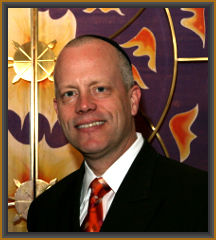
 |
December 22, 2023 (11 Tevet 5784) Parasha Vayigash - To Tree or Not To Tree: That is the Question
Dear Friends, I hope this correspondence finds you well and in good health. We look forward to you joining us this Saturday morning for Shabbat services, which will take place in our beautiful sanctuary beginning at 10:00 am. The services will also be available on our regular Zoom link, but we prefer you to come in person, so that you can participate in our festive Kiddush! A Zoom Kiddush just isn’t the same! During these holiday seasons, I am often asked a straightforward, but at the same time, complicated question: “Rabbi, is it ok for a Jewish family to have a Christmas Tree? After all, the non-Jews don’t pray to them.” My knee jerk reaction is an adamant “No,” but a fair and thoughtful question warrants a deliberate and thoughtful answer. Answering such an inquiry demands the identification of two anthropological terms. Acculturation, on the one hand, is the process through which a person or group from a minority culture comes to adopt the practices and values of the majority culture, while retaining their own cultural identity. Acculturation entails reframing the ethnic symbolism of the majority group’s practice into a reconceptualized symbol, subsequently attached with a meaning more resonant of the minority group’s particularism. Assimilation, on the other hand, is the process whereby the minority group’s identity and culture become subsumed entirely by the practices of the majority culture. In contemporary Judaism, it is arguable that acculturation is prevalent throughout our communities, whereas complete assimilation, often but not always a byproduct of intermarriage, can only be verified via longitudinal demographic studies. An anthropologist may therefore argue that we could potentially usurp the holiday tree custom, assuming it is adorned only with Jewish symbols, theology and meaning. A tree with a Jewish star and a picture of your favorite community Rabbi might even work! On the other hand, since Jews have been a minority group throughout history, the Torah does share the following warning in the Book of Leviticus, which was written before previous generations even entered the Holy Land: “We do not walk after the ways of the idolaters. We do not assimilate ourselves to them; not in our clothing and not in other things like this, as it says, ‘Do not walk after the ways of the gentiles’ (Vayikra 20:23).” Extending this scriptural line of reasoning, the famous Vilna Gaon went as far as to forbid decorating Shuls with trees and shrubs on Shavuot (!) because of the similarity to the non-Jewish custom of decorating with trees. This opinion is also mentioned by the Chayye Adam (composed by Avraham Danzig, an 18th century Lithuanian codifier of Jewish Law), Mishna Berura, and Aruch Hashulchan (composed by Yechiel Epstein, a 19th century codifier of Jewish Law). The Aruch Hashulchan even mentions that the custom of decorating Shuls on Shavuot with trees virtually disappeared from many communities due to the ban instituted by the Gaon of Vilna. In my opinion, it would be derogatory to assume that the Christmas Tree, is simply a cultural symbol and not a religious symbol. While Christianity certainly shares a pluralistic view of interpretation, religious traditions suggests that the tree itself, which is often an evergreen, is symbolic of the birth and resurrection of Jesus as Christ. Furthermore, the branches symbolize the crown of thorns worn by Jesus on the cross. The ornaments themselves represent character traits ascribed to Jesus such as peace, love, kindness, joy, goodness, faithfulness, and gentleness. The shining star, which typically caps the tree at the top, represents the oracle who guided the three Wise Men to Bethlehem for the purpose of announcing the arrival of the Messiah. From a cultic perspective, the bells represent the idea that Jesus is the new High Priest. The candy canes, as delectable and tooth-decaying as they may be, represent Jesus as God’s shepherd, as found in the famous Psalm 23 (“The Lord is my shepherd. I shall not want.”). Clearly, the tree is a symbol replete with Christian religious meaning. Extending the answer to the realm of the “theater of the absurd,” perhaps the biggest problem with a Jewish holiday tree is that there would be many Talmudic questions composed by the Rabbinic mind, as is done with all other matters of Halachic concern. Examples of those questions would include: Do you hang the lights from right to left and light them from left to right? Can you use the lights of the tree to read your newspaper? Do you say the blessings while decorating the tree or standing it up in your living room? Do you eat your meals beside the tree on all the nights of the holiday or only on the first night of the Yuntif? If a branch falls off, is the tree still kosher or does it need to be repaired ritually? Does one need to keep the remnants of the tree to utilize as the Schach (covering) for the next fall’s Sukkoth holiday? Personally, with apologies to well-meaning, sympathetic, bicultural anthropologists, I will avoid the dilemma altogether. Sharing ecumenical etiquette, I will sincerely wish my non-Jewish Christian neighbors a meaningful festival, and devotedly stick with my Sabbath tablecloth, wool-woven Tallit, Home Depot-assisted Sukkah, and modest Jewish Menorah! As we enter Shabbat and contemplate the holiday season, may we always respect the practices, beliefs, and traditions of others while embracing, enhancing, and enveloping the beauty of our Jewish symbols of peace, Torah and Mitzvoth. We can even start tonight. Good Shabbos and see you tomorrow! Shabbat Shalom, Rabbi Eric L. Wasser, EdD, Hon.DM
|